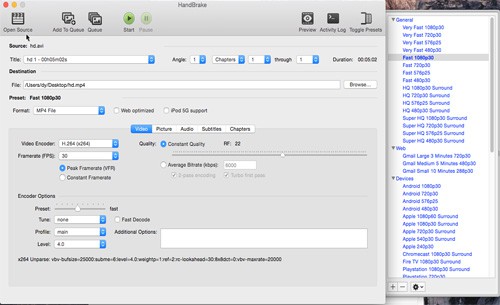

- Encoding software for mac like handbrake mp4#
- Encoding software for mac like handbrake windows#
You can then preview the converted clip immediately and decide if that preset works for your needs, or if should tinker with the settings or switch to another preset. If you’re converting a bunch of videos and are unsure about the quality of the preset you’ve selected, you can use the live preview to convert a small section of a video. The second standout feature is a live preview. Having trouble with uploading? Please visit this troubleshooting guide. Once the video has been exported, view your finished, compressed, file (via VLC or QuickTime) to make sure it looks and sounds correct, then upload it to Vimeo here.
Click the Start button at the top of the application to begin the encoding process. Once you are done with compression settings, you can move on to exporting your video. These aren't required for the average Vimeo video. We recommend using an editor like Audacity or FFmpeg. However, if your original file contains multiple audio tracks, you’ll need to merge all tracks before using Handbrake. If the extraneous audio tracks do not contain any audio information, you can simply select the one you wish to include in your final output. ⚠️ Remember: Multiple audio tracks are not supported on Vimeo. Or select None if you do not want to include audio in this video file. Select the audio track you'd like to include in your video file (if you only have one track, you can keep as the default). 💡 Remember: Lower data rates lead to smaller file sizes and faster uploads! Experiment to pick the lowest data rate that yields acceptable image quality. If your video contains above average visual complexity (such as a video with high levels of grain), increase the data rate. If your video contains below average visual complexity (such as a slideshow presentation), choose a lower data rate. *These data rates are suggested for average video files. Then, enter the average bitrate appropriate to your video file: For example, if your frame rate is 8 FPS, choose 16 FPS. If your frame rate is lower than 15 FPS: Choose a multiple of your frame rate that is between 15-30 FPS. For example, if your frame rate is 100 FPS, choose 60 FPS. If the frame rate of your file is higher than 60 FPS: Choose a factor of your frame rate that is between 15-60 FPS. *Although rare, there are some situations where you'll want to choose a frame rate different from the source: *If your video is HDR or above 4K (e.g 5K, 8K, etc), we recommend using H.265 (x265) *If your source footage is low quality, you may want to enable this feature to remove blocking artifacts. *If your source file is upside down, you can experiment with other values to fix it. (unless you want to convert your video to black & white) You can learn more about deinterlacing with Handbrake here. If you are not sure what type of source you have, it’s best to choose Off. Off *If your source file is interlaced you can select Yadif but we only recommend this if you are comfortable using Handbrake. *If you are de-interlacing your video (as described below), you can check this option to detect interlaced frames of video. 
These values should default to your source file's original dimensions. We list recommended settings for additional tabs in HandBrake below.ĭefault. You can enter a new file name or path manually, or select “Browse” to choose a new destination. This is the name and destination path of your output file. Web optimized, IPod 5G support, and Align A/V start should all remain unchecked. Handbrake will automatically choose an encoding preset, but once you begin editing, it will automatically adjust the default to “Modified”. Handbrake will automatically load this information from your original file.
Once your file is ready to go, Handbrake will automatically load in some default information:. HandBrake will scan the source file, which may take several seconds. Select the file that you want to work with, then click Open. If you accidentally bypass this step, you can also access the file selection menu by clicking File > Open Source, or by clicking the Open source button in the upper left-hand corner of the application. This is the original file you are looking to compress. When you open HandBrake, you will be prompted to select your source file. 
If you have a question about using HandBrake, or are running into an error, please check out HandBrake's Support FAQ. We include setting recommendations specific to HandBrake below based on nonexhaustive testing and user feedback newer options that HandBrake has added may not all be noted below. īe sure to reference our compression guidelines when encoding your video.
Encoding software for mac like handbrake windows#
It can be downloaded for Windows or Mac here.
Encoding software for mac like handbrake mp4#
HandBrake is a free program that can be used to compress and prepare MP4 videos for upload to Vimeo.







 0 kommentar(er)
0 kommentar(er)
